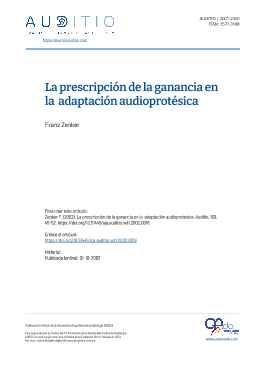La prescripción de la ganancia en la adaptación audioprotésica
DOI:
https://doi.org/10.51445/sja.auditio.vol1.2002.0018Palabras clave:
audioprótesis, adaptación, prescripción de la ganancia, NAL, DSL, IHAFF, POGO, FIG6Resumen
Los audífonos basados en la tecnología digital han fomentado la aparición de nuevas fórmulas de prescripción de la ganancia. En la actualidad existen dos grandes grupos de fórmulas: las genéricas, aplicables a cualquier tipo de audífono, como el DSL o el NAL-R y las fórmulas específicas desarrolladas por los fabricantes para modelo y marcas concretas de audífonos, como el ASAII de Oticon o el DIGITAL de Phonak. Ambos grupos de fórmulas poseen ventajas y limitaciones. Las fórmulas específicas son rápidas y no requieren grandes conocimientos. La fórmulas genéricas, por otro lado, permiten considerar de una forma amplia los aspectos diferenciadores de cada individuo en la prescripción final de la ganancia. En este artículo revisamos los principales métodos de prescripción de la ganancia genéricos al uso aparecidos en los últimos años.
Descargas
Visibility and Altmetrics
Métricas
Citas
Carhart R. (1946). Tests for selection of hearing aids. Laryngoscope. 56:780-94. https://doi.org/10.1288/00005537-194612000-00004
Watson y Knudsen V. (1940). Selective amplification in hearing aids. J Acoust Soc of Am. 18:401-8.
Lybarger S. (1944). Method of fitting hearing aids. U.S. Patent Applications S.N. 543,278.
Davis H, Hudgins C, Marquis R, et al. (1946). The selection of hearing aids. Laryngoscope. 56:85-163. https://doi.org/10.1288/00005537-194604000-00002
Teter D. (1989). Keynote address: Hearing aids and aural rehabilitation. Academy of Rehabilitation in Audiology, Summer Institute. Austin, TX.
Berger KW, Hagberg EN, Rane RL. (1988). Prescription of hearing aids: Rationale, Procedure and Results. 5th Edition, Herald Publishing, Kent OH.
Cornelisse LE, Seewald RC, Jamieson DG. (1995). The input output fórmula: A theoretical approach to the fitting of personal amplification devices. J Acoust Soc Am. 97:1854-64. https://doi.org/10.1121/1.412980
Hawkins D. (1992). Prescriptive approaches to selection of gain and frequency response, In: Mueller HG, Hawkins DB, Northern JL, editors. Probe tube microphone measurements: hearing aid selection and assessment. San Diego, CA: Singular Publishing.
Byrne D. (1993). Hearing aid gain and frequency response selection strategies. In: Studebaker GA, Hochberg I, editors. Acoustic factors affecting hearing aid performance. Boston: Allyn and Bacon.
McCandless G. (1994). Hearing aid fórmulae and their application, In: Sandlin R, editor. Hearing aid handbook: volume I theoretical and technical considerations. San Diego, CA: College-Hill Press.
Kießling J. Hearing aid fitting and verification strategies , OtoAcademy, CRS Amplifon.com (citado 1 de agosto de 2001). Unavailable resource, closest similariy: https://doi.org/10.1080/010503901300007074
McCandless G. y Lyregaard P. (1983). Prescription of gain and output (POGO) for hearing aids. Hear Instr. 34:16-21.
Byrne D, Dillion H. (1986). The National Acoustic Laboratories (NAL) new procedure for selecting the gain and frequency response of a hearing aid. Ear Hear. 7:257-65. https://doi.org/10.1097/00003446-198608000-00007
Killion M. y Fikret-Pasa. (1993). The three types of sensorineural hearing loss: loudness and intelligibility consideration. Hear J.46:31-6.
Seewald RC. (1995). The Desired Sensation Level (DSL) method for hearing aid fitting in infants and children. Phonak Focus Nr. 20.
Dillon H, Katsch R, Byrne D, Ching T, Keidser G, Brewer S. (1998). The NAL-NL1 prescription procedure for non-linear hearing aids. NAL Annual Report 1997/98, 4-8. https://doi.org/10.1097/00025572-199904000-00002
Allen JB, Hall JL, Jeng PS. (1990) Loudness growth in 1/2-octave bands (LGOB) - A procedure for the assessment of loudness. J Acoust Soc Am 88, 745-753. https://doi.org/10.1121/1.399778
Kießling J. (1997) Versorgung mit Hörgeräten. In: Kießling J, Kollmeier B, Diller G: Versorgung und Rehabilitation mit Hörgeräten. Thieme Verlag Stuttgart, 49-109.
Haubold J. (1996). Zukünftige Hörgeräteanpassung aus der Sicht der Hörgeräteakustik. 8. Multidisziplinäres Kolloquium der Geers-Stiftung, Band 11, 147-163.
Moore BCJ, Alcantara JI, Glasberg BR. (1998). Development and evaluation of a procedure for fitting multi-channel compression hearing aids. Br J Audiol 32 (1998) 177-195. https://doi.org/10.3109/03005364000000062
Pastoors AD, Gebhart TM, Kiessling J. (1999). A fitting strategy for digital hearing aids based on loudness and sound quality. Proceedings of 4th European Conference on Audiology, Scand Audiol Suppl. (in press).
Schum, D. (1996). Adaptive Speech Alignment: A new fitting rationale made possible by DSP. The Hearing Journal, 49:5, 25-30.
Ludvigsen C. y Topholm J. (1997). Fitting a wide dynamic range hearing instrument using real ear threshold data: a new strategy. Hear Rev: High Performance Solutions 2:37-39.
Byrne D. y Tonnisson W. (1976). Selecting gain of hearing aids for persons with sensorineural hearing impairments. Scand Audiol. 5:51-9. https://doi.org/10.3109/01050397609043095
Mueller HG. (1992). Individualizing the ordering of custom hearing aids, In: Mueller HG, Hawkins DB, Northern JL, editors. Probe-microphone measurements: hearing aid selection and assessment, San Diego, CA: Singular Publications.
Bryne D, Parkinson A, Newell P. (1990). Hearing aid gain and frequency response requirements for the severely/profoundly hearing impaired. Ear Hear 1990;11:40-9. https://doi.org/10.1097/00003446-199002000-00009
Byrne D, Parkinson A, Newell P. (1991) Modified hearing aid selection procedures for severe/profound hearing losses. In: Studebaker G, Bess F, Beck L, editors. The Vanderbilt hearing aid report II. Parton, MD: York Press; 1991. p. 295-300.
Schwartz D, Lyregaard P, Lundh P. (1988). Hearing aid selection for severe-to-profound hearing loss. Hear J. 41:13-7.
Mueller H.B. (1995). Prescriptive hearing aid fitting, current issues in amplification. St. Louis, MO: Washington University.
Delgado J. y Zenker F. (2002). El promedio del espectro del habla: Fundamentos y aplicaciones clínicas. Auditio: Revista electrónica de audiología. 1(3)41-44. https://doi.org/10.51445/sja.auditio.vol1.2002.0017
Zenker F. y Barajas J. (1999). Adaptación de audífonos en función del promedio del espectro de la palabra hablada. Estudio de un caso único. En: Logopedia escolar y clínica. Últimos avances en Evaluación e Intervención. Editor: José Domingo Martín Espino, Madrid, Editorial CEPE, pp. 329-336.
Pascoe, D.L. (1988). Clinical measurements of the auditory dynamic range and their relation to formulas for hearing aid gain. In J. Hensen (Ed.), Hearing aid fitting: Theoretical and practical views (pp. 129-152). Proceedings of the 13th Danavox Symposium, Copenhagen.
Van Vliet D. (1995). Determining contour loudness judgements. Hear Instr. 46(March):30.
Cox R. (1995). Using loudness data for hearing aid selection: the IHAFF approach. Hear J.48:2, 10, 39-44. https://doi.org/10.1097/00025572-199502000-00001
IHAFF. (1994). A comprehensive hearing aid fitting protocol, distributed at Jackson Hole Rendezvous. Jackson, WY.
Valente M. y Van Vliet D.(1997). The independent hearing aid fitting forum (IHAFF) protocol. Trends in Amplification, 2(1),6-35. https://doi.org/10.1177/108471389700200102
Cox R, Goff CM, Martin SE, McLoud LL. (1994). The contour test: normative data, Presented at the AAA Convention. Richmond, VA.
Killion M. (1994). FIG6. Jackson Hole Rendezvous. Jackson, WY.
Sullivan R. (1988). Probe tube microphone placement near the tympanic membrane. Hear Instr. 39:43-4, 60.
Byrne D, Dillon H, Ching T, Katsch R & Keidser G. (2001). NAL-NL1 procedure for fitting nonlinear hearing aids: Characteristics and comparisons with other fitting methods. Jour AAA, 12 (1): 37-51.
Rankovic CM. (1991). An application of the articulation index to hearing aid fitting. Journal of Speech and Hearing Research. 34:391-402. https://doi.org/10.1044/jshr.3402.391

Publicado
Versiones
- 2021-09-15 (2)
- 2002-10-01 (1)
Cómo citar
Número
Sección
Licencia
Derechos de autor 2002 Auditio

Esta obra está bajo una licencia Creative Commons Reconocimiento 3.0 Unported.
Artículos publicados después de 2020
Los autores retienen el copyright y dan permiso y derecho a la revista para publicar su primera publicación bajo licencia, si no se expresa lo contrario. Creative Commons Attribution License la cual permite a otros el compartir siempre que se de reconocimiento a los autores de la publicación en esta revista. Si los autores deseasen aplicar ciertas restricciones en su permiso para usos no comerciales u obras derivadas, éstos podrán elegir entre las siguientes licencias:
https://creativecommons.org/about/cclicenses/
Publicaciones 2001-2020
Los textos publicados en esta revista en la seccion de "AUDITIO 2001-2020 están sujetos –si no se indica lo contrario– a una licencia de Reconocimiento 3.0 España de Creative Commons. Puede copiarlos, distribuirlos, comunicarlos públicamente, hacer obras derivadas y usos comerciales siempre que reconozca los créditos de las obras (autoría, nombre de la revista, institución editora) de la manera especificada por los autores o por la revista. La licencia completa se puede consultar en http://creativecommons.org/licenses/by/3.0/es/deed.es.








 AUDITIO | Spanish Journal of Audiology
AUDITIO | Spanish Journal of Audiology
